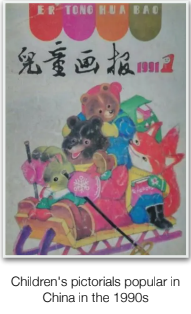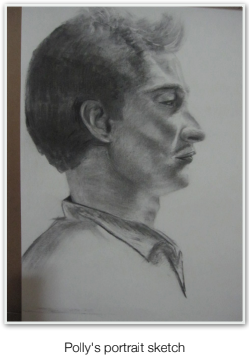My Journey of Learning Painting and Dedicating Love
Polly Zhang
Personal Statement
Hello, my name is Polly Zhang. This work is an assignment I did from my English 101 course at LWTech, it is about my insights into dedicating love to people in need through painting, and a precious journey in my life. My instructor is Wesley Mantooth, who encouraged me to submit the writing to our school’s “student showcase” magazine.
For the last decade, I have often been called a “literary young female” by my friends—I enjoy reading, painting, photography, and Chinese opera. My enlightenment from these hobbies is all because of my mother—she can sing Chinese opera and write traditional Chinese calligraphy, and she is often invited to participate in exhibitions of these arts.
I remember that when I was around four or five years old, my mother bought me a lot of children’s pictorials with simple storylines and corresponding pictures. I really liked reading such books. At that time, I didn’t know how to read, so I just looked at different pictures to guess the plots of stories and tell them to my doll without hesitation. After a couple of months, my mother was happy to buy more books for me. There were children’s serial story periodicals, poetry collections, and arts newspapers. In the book corner of the kindergarten, we had 30 minutes of reading time every afternoon, often just before we were ready to leave school. Many times I burst into tears because I couldn’t bear to put down a picture book. My mother always coaxed me home with embarrassment. Maybe at that time, there was already a seed in my heart that liked painting and was looking forward to sprouting, but it waited to be discovered because I was too young to hold a pen.
When I learned how to hold a pen and write in elementary school, I started drawing simple outlines of animals and flowers in my notebooks. I like to choose some themes for my depictions—for instance, I named the depictions of a big tree and rabbit “a rabbit under the big tree,” and I named the depictions of a river and turtle “a turtle in the water.” I made those notebooks my secret garden, where I could slowly draw pictures with clumsy brushstrokes that I found lovely. I had many of these notebooks— they filled my teenage years, and the pictures depicted ranged from simple outlines of animals and flowers to detailed Japanese cartoon characters. My drawing was still immature, but I really enjoyed the process of it. This secret stayed with me until I was admitted to high school.
One afternoon in the fall of 2002 my mother asked me before sending me off to boarding school: “Your school supplies are ready now. What else do you need? Let me know.”
“What I really need is a sketchbook,” I said.
“Why? You don’t need that, you just need to learn in school.”
“Mom, I——”
I didn’t complete my request, because typical Chinese parents believed that the most important thing was to study hard for the courses that were required in school, not spend time and money developing hobbies. People were increasing their salaries in the 2000s with the development of the economy, but wanting to spend $2,500 or more to learn how to draw was obviously expensive, which meant my parents would have difficulty to afford it. Meanwhile, my passion for painting could not be stopped, and I told myself “I can continue to draw in notebooks.”
The fate-changing moment came just in time. I was selected as the head of the propaganda department of the student council because I had held the same position in middle school. Every year I organized students to complete the posters for the New Year’s party, and every quarter I designed the classroom’s theme blackboard by typesetting, drawing, and writing on a large blackboard with colored chalk. It happened near the opening ceremony of a sports meeting in my first year of high school—we, the propaganda department of the student council, made amazing posters and won the school’s award. Thus, I caught the eye of my art teacher, Mr. Qiu. He saw my painting and recommended me to a studio with teaching qualifications. My tuition was $1,500, a reduction of $1,000 because I had been recommended by the school. After my parents knew that I had been secretly drawing in notebooks for several years, they prepared my painting tuition and sent it to the studio the next day. From then on, I would go to the studio every weekend with my drawing board, a bucket of drawing paper, and a paint box to learn the theory of painting, understand sketching and oil painting, practice drawing three-dimensional triangular cones, and finally sketch plaster figures. I spent a whole year practicing sketching a plaster cast of Michelangelo’s David. That’s when I really started learning to draw professionally.
In 2005, I was in my third year of high school. This was a critical and stressful academic year—I was preparing for the Gaokao (a national college entrance examination, similar to the SAT exam in the US. In China, there is only one chance to take the exam. If they fail, students can only reapply for the next year’s exam). When I discussed with my parents about applying to universities, they strongly supported me in taking the art design major. In order to be admitted as an undergraduate, I spent the most time on study and drawing. After the Gaokao, I got my wish and received an offer letter from one of my top-choice universities—Nanjing University of Finance & Economics. When I was in college, I participated as a volunteer—helping some students who loved painting but whose families couldn’t afford tuition to learn painting and the basic theories behind it. This experience gave me a deeper understanding that it is not easy to pursue dreams and that I should cherish every opportunity if I could.
After I graduated from college in 2009, I faced making a decision about my career path. Following my mother’s suggestion, I became a high school teacher. Fortunately, I was able to teach art. I enjoyed working at school because in this way I inspired many students’ painting interests and supported them to pursue what they love to do. I applied to my academic dean for a bigger classroom as a painting studio and welcomed every student who wanted to draw. I shared with them about my experience learning painting and told them to cherish the priceless treasures of support from parents, school, and society.
My parents also supported me in another meaningful effort: I organized the students who joined the school painting club as volunteers at the Jiabainong Orphanage in Pudong, Shanghai, once a month. Founded in 2011 by Christians, this orphanage mainly takes in abandoned children suffering from diseases such as congenital heart disease or disabilities. My students brought pictorials to the orphanage to tell stories to the children, taught them to hold pencils to draw, and played games with them. We prepared fruits to share with the children, and we also blessed the adopted children. Laughter and love filled the orphanage. How meaningful and beautiful this was—it will leave a deep impression on our lives for a long time. We need to remember to help people in need—this is the transmission of love. I love not only painting but teaching students to paint and using painting to convey love to society. When we spread such love, our hearts will be filled with joy and the world will appear more beautiful as a result.




